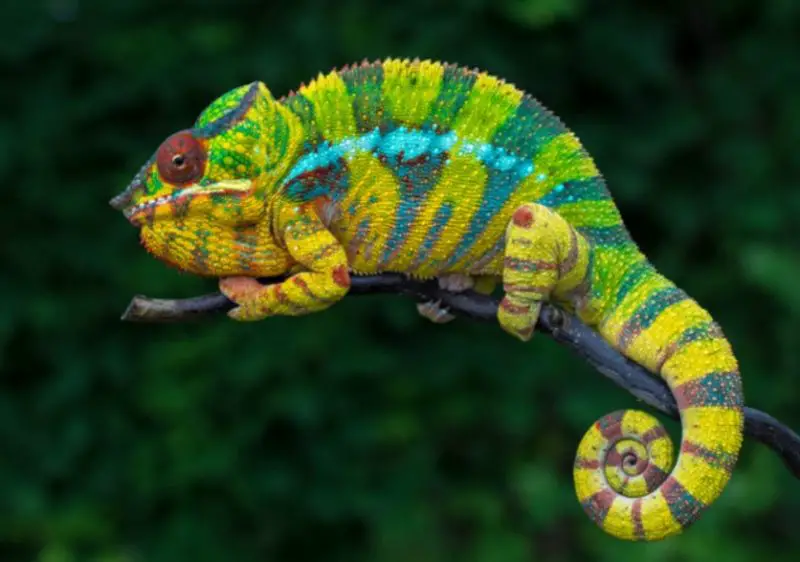Panther chameleons (Furcifer pardalis) are among the most colorful and captivating reptiles in the pet trade. Native to Madagascar, these reptiles are known for their vibrant hues and dynamic color changes. But if you’re considering bringing one into your home, it’s crucial to understand their lifespan, especially in captivity.
How long do they live, and what factors influence their longevity? Let’s dive deep into the world of panther chameleons and explore everything you need to know about their lifespan in captivity.
Understanding Panther Chameleon Lifespan

Average Lifespan in Captivity
In captivity, panther chameleons typically live between 5 to 7 years, with some individuals reaching up to 8 or even 9 years with exceptional care. Males generally live longer than females due to differences in reproductive stress. While females may live around 3 to 5 years, males often surpass this, thriving for up to 7 years or more.
This disparity is primarily because female panther chameleons undergo egg-laying cycles, which can be taxing on their bodies, even if they are not bred. These cycles increase their nutritional needs and overall stress, potentially shortening their lifespan.
Lifespan Comparison: Captivity vs. Wild
In the wild, panther chameleons have a slightly shorter lifespan, typically ranging from 2 to 4 years. This is due to various environmental challenges, including predators, disease, and inconsistent food supply. In captivity, with a controlled environment and proper care, they are shielded from many of these threats, allowing them to live longer.
Factors Affecting Panther Chameleon Lifespan
Diet and Nutrition
A balanced and nutritious diet is crucial for the health and longevity of panther chameleons. In captivity, they primarily consume insects like crickets, dubia roaches, and mealworms. However, it’s not just about feeding them insects – the quality and variety of food matter.
To maximize their lifespan:
- Gut-load the insects with nutrient-rich vegetables before feeding them to the chameleon. This ensures they receive essential vitamins and minerals.
- Supplement their diet with calcium and multivitamin powders to prevent deficiencies and related health issues, such as metabolic bone disease.
Proper Housing and Environment
Creating a habitat that closely mimics their natural environment is key to their well-being. Factors to consider include:
- Temperature and Humidity: Panther chameleons thrive in temperatures between 75°F to 85°F during the day and a nighttime drop to 65°F to 75°F. Humidity should be maintained between 50% to 70%, achieved through misting and proper ventilation.
- Lighting: UVB lighting is essential for calcium absorption and bone health. Without it, chameleons can develop metabolic bone disease, significantly reducing their lifespan.
- Space and Climbing Opportunities: They need ample space to climb and explore. A vertical enclosure with live plants provides mental stimulation and mimics their natural habitat.
Hydration and Humidity Management
Panther chameleons get their hydration from droplets on leaves, not from standing water. Inadequate hydration can lead to dehydration and kidney issues, which are common causes of premature death in captivity. Regular misting systems or drippers are recommended to maintain the required humidity levels.
Handling and Stress
Panther chameleons are known for being solitary and easily stressed by excessive handling. Unlike other reptiles, they do not enjoy being held frequently. Limiting interaction to necessary care routines reduces stress and contributes to a longer lifespan.
Health and Veterinary Care
Routine health check-ups and immediate attention to health issues are crucial. Common health concerns include:
- Respiratory infections due to improper humidity levels.
- Metabolic bone disease from inadequate UVB exposure or calcium deficiency.
- Parasites that can be introduced through live food.
An experienced reptile veterinarian should be consulted for regular health assessments and when any abnormal behavior is observed.
Differences in Male and Female Lifespan
Why Do Males Live Longer?
Male panther chameleons generally live longer than females due to the absence of reproductive stress. Females undergo regular egg-laying cycles, even without mating. This process demands high nutritional intake and puts considerable strain on their bodies, making them more prone to health issues.
Managing Female Reproductive Health
To increase the lifespan of female panther chameleons:
- Regulate breeding cycles to minimize stress.
- Provide proper calcium supplementation to support egg development.
- Create a laying bin within their enclosure to ensure safe and stress-free egg-laying.
By managing these reproductive aspects, female panther chameleons can live healthier and potentially longer lives.
How to Maximize Panther Chameleon Lifespan
Optimal Diet and Supplementation
Provide a varied diet of gut-loaded insects, such as crickets, silkworms, and dubia roaches. Rotate food sources to ensure a balance of nutrients. Supplement their diet with calcium (without phosphorus) and a multivitamin powder containing Vitamin D3, but avoid over-supplementation.
Proper Lighting and Heating
Ensure they receive 12 hours of UVB light daily to facilitate calcium absorption. A basking spot with temperatures around 85°F allows for proper thermoregulation, which is vital for digestion and overall health.
Hydration and Humidity
Maintain a consistent humidity level by misting the enclosure several times a day. Using a dripper system ensures they have access to water droplets, preventing dehydration.
Mental and Physical Stimulation
A well-decorated enclosure with live plants, vines, and branches encourages natural climbing behavior, promoting physical activity and reducing boredom.
Minimal Handling
Limit handling to avoid unnecessary stress. Observing their behavior and health without excessive interaction is the best approach to ensuring a long and healthy life.
Signs of a Healthy Panther Chameleon
A healthy panther chameleon exhibits the following signs:
- Bright and vibrant coloration
- Alert and active behavior
- Clear eyes without discharge
- Regular eating and defecation patterns
- Strong grip and agile movement
Conversely, signs of potential health issues include:
- Dull or darkened coloration indicating stress or illness.
- Lethargy or decreased activity which may signal underlying health problems.
- Swollen joints or crooked limbs suggesting metabolic bone disease.
If any of these symptoms are observed, it’s essential to seek veterinary care promptly.
Conclusion: Ensuring a Long and Healthy Life for Panther Chameleons
Panther chameleons are remarkable reptiles with unique needs. In captivity, they can live 5 to 7 years, and with exceptional care, some may even reach 8 or 9 years. Males generally outlive females due to the latter’s reproductive demands.
To maximize their lifespan:
- Provide a balanced, nutritious diet with appropriate supplements.
- Maintain optimal temperature, humidity, and UVB exposure.
- Ensure minimal handling to reduce stress.
- Regularly monitor health and seek veterinary care when needed.
By understanding their specific needs and providing the best possible care, you can help your panther chameleon live a long, healthy, and vibrant life.






